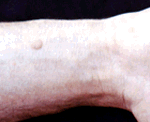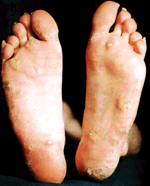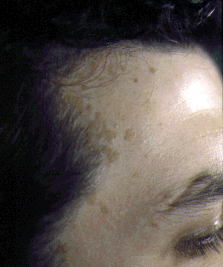VERRUCAE (Warts)
Causative agent is Human Papilloma Virus (HPV).
 1. Verruca Vulgaris 1. Verruca Vulgaris
This mainly involves hands. Elementary lesion is papule. Surface of this
papule is hyperkeratotic and papillamatous. Papules are generally multiple.
Diameters of these papules are under 0.5 cm. Satellite lesions in the periphery
occur by trauma (Köbner phenomenon). The patients have not subjective
symptoms, but may have pain after trauma if they have warts around and/or
under the nails.
 2. Verruca Plantaris 2. Verruca Plantaris
This is a kind of verruca vulgaris that involves plantar area. Papules are
flat because of pressure. These mainly occur on traumatic areas and pressure
leads to pain. Differential diagnosis must be made with cores. Papillamatosis
is a feature of verrucae and trauma leads to punctate hemorrhages at the top
of the papillae, so one can see black dots in the verrucous area.
 3. Verruca Planus 3. Verruca Planus
The color of the papule is generally dark or brown. Multiple papules
are in several millimeters of diameter, slightly elevated and plain. They
are mainly localized on the hands and face. They are difficultly distinguished
if they are in flesh color, but the patient attends to a dermatologist for dark
spots if they are brown.
4. Verruca Filiformis
Warts with a long thread-like stalk and finger-shaped excrescences are called
as verruca filiformis. These types occur on beard, scalp and/or around nostrils.
Shaving supports the spreading (Köbner phenomenon).
 5. Verruca Anogenitalis (Condyloma accuminata) 5. Verruca Anogenitalis (Condyloma accuminata)
They are in flesh color or brown. Flat papules or vegetating masses may
be seen. In the perianal region warts are compressed laterally and are often
cockscomb-like. Some of them tend to malignancy.
Treatment
Warts may spontaneously heal. Dermatologist may wait for a while if the
patient have a few papules and have not any complaint. Treatment is necessary
for the patients have pain or spreading lesions. Electro-coagulation, cryotherapy,
acid applications and lastly surgical interventions may be thought.
|